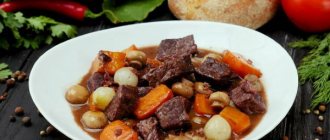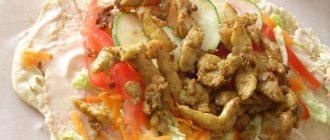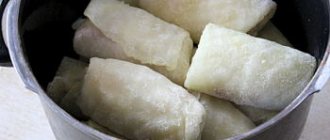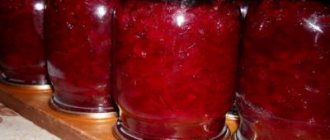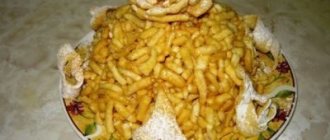Pilaf with pork and dried fruits
Pilaf with dried fruits has a very original taste and is definitely worth making. The dish is best served hot. You can easily make a salad of fresh vegetables with it.
Ingredients:
- Rice – 150 grams
- Pork – 100 grams
- Carrots – 1 piece
- Onion - 1/4 pieces
- Water – 1 glass
- Vegetable oil - 30 Milliliters
- Raisins – 20 grams
- Dried apricots – 40 grams
- Salt - To taste
- Ground black pepper - To taste
Number of servings: 5
How to cook:
Pour oil into a frying pan, add chopped meat, onion and grated carrots. Fry everything for 2-3 minutes. Place washed rice on top. Then add the washed raisins and dried apricots cut into smaller pieces. Pour in water, add salt and ground black pepper. Cover the pan with a lid and simmer the pilaf for 15-20 minutes. Then turn off the heat and let it sit for another 10-15 minutes. Pilaf is ready! Bon appetit!
Pilaf for the delight of those with a sweet tooth
Be sure to try the sweet pilaf with raisins and dried apricots. Let's complement the taste of the dish with prunes. The aroma of this pilaf will instantly gather your household at the dinner table.
Compound:
- 1 tbsp. rice;
- 70 g prunes;
- 70 g dried apricots;
- 50 g raisins;
- carrot;
- 2 tbsp. l. soft butter;
- filtered water;
- granulated sugar and honey to taste.
Preparation:
- Pour water over the dried fruits and leave to swell, then salt the liquid and cut the prunes and dried apricots into pieces.
- Peel the carrots and grate finely.
- In a frying pan with high sides, melt the butter and add the carrots. Sauté it for several minutes.
- Then add raisins, dried apricots and prunes to the carrots and fry for 13-15 minutes.
- Wash the rice grains thoroughly and sort them.
- Place the rice in a frying pan on top of the carrots and dried fruits and carefully distribute it over the entire surface.
- Pour in filtered water. It should cover all the ingredients by about one and a half centimeters.
- Add honey and granulated sugar. Determine the quantity based on your own taste preferences.
- Simmer the pilaf on the lowest burner level under a closed lid until the rice is ready. It should absorb all the water.
- Mix the finished pilaf and place into portioned plates. And to make pilaf with raisins, dried apricots, and prunes more vibrant and tasty, decorate it with your favorite fruits, for example, pieces of kiwi.
Sweet pilaf with dried fruits
A wonderful dish of oriental cuisine, pilaf has become widely known and loved by many for its taste and satiety, and is no longer mistakenly considered a porridge made from rice cooked in a special way.
As a lover of dried fruits, I often cook lean sweet pilaf with them. I suggest you cook one of my favorite recipes.
A large amount of dried fruits makes this pilaf tasty and sweet without adding sugar, and interesting for those who want to eat less sugar.
Compound:
for 4 servings
- 200 g (250 ml) long or medium grain rice
- 160 g of dried fruits, including: – 50 g each of dried apricots and prunes – 30 g each of raisins and dates
- 30 g vegetable oil (or 40 g butter)
- 1-2 tsp. anise seeds
- 1/3 tsp. salt (to taste)
- 500 g cold water (for soaking dried fruits)
Pilaf with dried fruits - recipe:
- Prepare all ingredients.
Ingredients
- Wash dried fruits and soak briefly for up to 30 minutes.
Then rinse under running water. This pre-soaking is necessary because all dried fruits that are sold in markets and stores are treated with sulfur dioxide (sulfur dioxide) so that they are stored better and longer. This coating can be easily removed by soaking in water, in which sulfur dioxide easily dissolves. For added cleanliness, I also add baking soda when rinsing. - Pour washed and peeled dried fruits with cold water for 1-2 hours to swell and obtain an infusion.
Soaking dried fruits
- Also soak the washed rice for one hour, pouring hot water over it (temperature about 60 degrees).
This is a mandatory step in the preparation of any pilaf, which distinguishes this dish, for example, from cooking rice with vegetables, so that we do not end up with rice porridge. During such hot soaking, rice releases the powder with which it is covered and starch from its surface into the water. If the rice is very starchy, then after about half an hour the water that has cooled down should be drained and refilled with hot water.ARTICLES ON THE TOPIC:
- The fastest pilaf in pots: step-by-step recipes
Pilaf in a frying pan with beef recipes with photos, how to cook
- Vegetarian pilaf - step-by-step recipe with photos
- After soaking, rinse the rice with warm running water (not cold, so that the rice grains do not crack before it has time to cool before adding it to the cauldron), stirring it in a container with water, draining it and adding a new one. When the water becomes clear, place the washed rice in a sieve.
Rinse
- After soaking, place the dried fruits in a sieve and cut into pieces. Do not pour out the infusion.
Cutting dried fruits
- If necessary, add more water to the left infusion, bringing it to the required amount (up to 350-400 ml). Then put it on the fire, not forgetting to add salt.
Heat the infusion
- Pour some of the vegetable oil into a heated hot cauldron (or pan with a thick bottom and walls).
Heat the oil in a cauldron
- Add some anise seeds (optional).
Roasting anise
- Spread 1/3 of the rice in an even layer.
Making a rice layer
- Place half of the prepared dried fruits on top.
Lay out dried fruits
- Then again lay out the next 1/3 of the rice. And on it - the remaining half of the dried fruits.
Repeat layers
- Sprinkle with remaining anise seeds.
Sprinkle with anise
- Place the last 1/3 of the rice on top.
Spread the remaining rice
Important: Spread the rice without compacting it too much. It should take up the free space between the dried fruits. This will push the oil up from the bottom layer of rice so that it is distributed between the rice grains.
- Pour the rest of the vegetable oil on top and carefully pour the salted hot infusion along the walls of the cauldron (this will prevent the top layer of rice from being washed out). It should cover the top layer of rice.
Pour oil and infusion
- Close the lid of the cauldron and cook the pilaf over low heat until done, i.e. approximately 25-30 minutes depending on the type of rice.
Cook until done
Soaking rice
Finally, sweet pilaf with dried fruits is ready!
Having carefully mixed (loose) it, put it on plates and serve.
In addition to being served on everyday occasions, this delicious sweet Lenten pilaf with dried fruits will also be a worthy dish on the festive Christmas table.
Bon appetit!
Fruit pilaf
Fruit pilaf recipe ingredients
- 300 g rice (I used steamed long grain rice);
- 150 g dried fruits (dried apricots, raisins, prunes);
- 1 apple;
- 20-30 g butter;
- 2-4 tsp. Sahara.
Optional:
- 1 tsp. cinnamon;
- 1/3 tsp. turmeric.
How to cook fruit pilaf in a slow cooker, step-by-step recipe with photos
I make fruit pilaf exactly the same way my mother cooked it. On my own, I added only turmeric - for a beautiful color and cinnamon - for aroma, but these spices are optional. I like crumbly rice, so I use steamed long-grain rice - it does not stick together when cooked. I took dried fruits in the following proportion: 2 parts dried apricots, one part each raisins and prunes. Two teaspoons of sugar was enough for me, but if you like it sweeter, add all four! I cooked this pilaf today in a slow cooker, because I went for a walk with the children, and upon returning I needed a ready-made hot dinner. You will need a medium saucepan with a lid, preferably with a thick bottom!
Let's prepare dried fruits: I rinse them with hot water, then cut them into small pieces (to make it easier for children to eat), but you can cut them larger, for example, into quarters.
Cut the apple into cubes, I leave the peel - this way the apple will be more noticeable in the finished dish.
Lightly grease the bottom of the cooking dish with butter. Pour in half a portion of rice and smooth it out. Place half of the dried fruits and apple on top, sprinkle with 1/2 tsp. cinnamon, 1-2 tsp. Sahara. Spread some of the butter. Form the second layer in the same way: remaining rice, dried fruits, apple, cinnamon, sugar, butter.
Dilute turmeric in a glass of water.
Pour in the future pilaf. Add more water so that the liquid level is one finger higher than the level of the rice (1.5-2 cm). All I needed was 750 ml of water.
If you are the happy owner of a multicooker, use the porridge/cereals mode for 30 minutes, or 20 minutes + 15 minutes for heating. If you cook on the stove, cover the pan with a lid and bring to a boil, then cook over low heat, with the lid ajar, for 20-30 minutes, until the rice has absorbed all the water and becomes soft.
Mix the finished pilaf.
This amount of ingredients yields 3-4 servings of unusual sweet fruit pilaf! If it's interesting, try it. And if it’s not very sweet, add honey to the finished dish! Bon appetit!
Lenten pilaf with dried fruits
Delicious during Lent – it’s possible and absolutely easy! Recipe for lean pilaf with dried fruits in our culinary master class today. During the days of fasting, you probably also had to celebrate some family holidays. Although Lent does not provide for big celebrations and entertainment, you still want to celebrate children’s birthdays or cozy home gatherings with delicious dishes. Such a lean pilaf with dried fruits will look very festive and at the same time “chaste”; it is hearty and will appeal to all your guests, regardless of age.
Dried fruits add an incredible fruity note to the taste of the pilaf, successfully complement all other ingredients, and we can say that the absence of a meat component is not even remembered after the first spoon of the treat...
To prepare pilaf with dried fruits without meat you will need:
- rice – 1 cup
- onions – 2 pcs.
- carrots – 2 pcs.
- garlic – 1 head
- dried fruits (prunes, raisins, dried apricots) – 300 g
- cumin/jeera – 1 tbsp.
- turmeric – 0.5 tbsp.
- hot chili pepper – 0.25 pods
- salt - to taste
- vegetable oil – 100 ml
Lenten pilaf with dried fruits – recipe with photo:
To prepare pilaf, we take a suitable variety of rice - long-grained, which will crumble after boiling and will not stick together in lumps. We rinse the rice in cold water, and immediately prepare a set of dried fruits. They need to be washed, cut into smaller or medium-sized pieces, for example, you can simply cut dried apricots and prunes in half or into smaller cubes. We simply wash the raisins. If your dried apricots or prunes are too dry and wrinkled, we still recommend soaking such dried fruits for several hours in warm water to swell before adding them to pilaf. Otherwise, during the process of preparing pilaf, they simply will not have time to absorb enough liquid, and as a result, the pilaf will not contain steamed, aromatic and delicious fruit pieces, but sweet “drying”.
We proceed directly to preparing lean pilaf: cut the onions into half rings.
Heat the oil in a frying pan; the amount should be such that the onion “floats” freely in it and is well fried on all sides. Fry the onion until the thinnest half rings are golden and a sweetish aroma of fried onions appears, do not forget to stir.
Add dried fruits to the onions, fry the dried fruits and onions for a few minutes.
We send the carrots, chopped into cubes, and continue sautéing until the carrots become slightly softened.
At the same time we prepare herbs and spices for adding to the pilaf: lightly grind the cumin (cumin) in a mortar so that its incomparable aroma is more pronounced, remove as much of the husk as possible from the head of garlic, but leave the cloves themselves on the central core, cut the chili pepper into rings (5-6 rings will be enough to balance the taste).
Add salt, turmeric, cumin, chili pepper to the hot carrot-fruit mixture.
Place a head of garlic in the center, pour 100-120 ml of hot water into the frying pan. Cover with a lid and let simmer on low for 10 minutes, thereby revealing the taste and aroma of the spices, and steaming the dried fruits and garlic even more.
Now it's the turn of the rice - you need to distribute it evenly throughout the steamed mass and add hot water so that the rice is covered by about 1 cm if you cook in a wide frying pan, and about 2 cm if you cook in a cauldron. Don't be afraid of a lack of liquid - you can always add it during the process if you see that there is no water left in the pan and your rice is not ready yet.
Let the pilaf with dried fruits cook for another 20 minutes, covered over low heat, then turn off the heat and leave it for another 10 minutes to absorb the remaining liquid.
Mix the rice with the rest of the mixture only at the end of cooking or just before serving.
Lenten pilaf with dried fruits is ready!
Bon appetit!
Pilaf with prunes and raisins (step by step)
Ingredients:
- rice - 100 gr.;
- carrots - 1 pc.;
- onion - 1 pc.;
- prunes - 50 gr.;
- dark raisins - 50g;
- vegetable oil - 10 ml;
- salt - to taste;
- granulated sugar - to taste
Cooking:
- For dried fruits, I usually take raisins, dried apricots and prunes. I cook with vegetable oil.
- I make pilaf one time at a time so I can eat it fresh. It cooks much faster than usual - meat. Yes, and easier.
- In advance, I take raisins and prunes, wash them and pour boiling water for about 20 minutes, then squeeze out the excess water from the berries.
- I also prepare the rice in advance: I wash it and pour boiling water in a plate.
- Wash the carrots, peel them and cut them into small cubes. I cut a small onion into small pieces.
- Simmer the carrots and onions in vegetable oil until the carrots are ready.
- I cut the prunes into pieces and add them to the pan with the vegetables along with the raisins. I add a little water and simmer for about five minutes.
- I add rice and fill the kettle with hot water.
- I add salt and sugar. You can add more sugar, but my prunes are very sweet. I close the lid and simmer until the rice is ready. The rice becomes a pleasant beige color - colored with prunes. Very tasty!
- Lenten pilaf with dried fruits turns out very tasty and satisfying. Plus it's very useful.
Fergana pilaf for vegetarians
This pilaf recipe turned out very unexpectedly, and all because we now have two vegetarians in our family. And it was like this: while the whole family ate meat, when we went out into the countryside we made pilaf with meat, according to the recipe of Stalik Khankishiev - Fergana pilaf. And then, suddenly there were vegetarians in the family who don’t eat this, but they still wanted pilaf and had to come up with a completely new recipe - Fergana pilaf with dried fruits. I liked this pilaf more than the one with meat. The taste turns out to be much more interesting and unusual; due to the presence of dried fruits, both sweetness and slight sourness appear... Mmmm... Delicious! What about meat?! Convinced meat eaters will ask. But meat is not needed here and without it it turns out very tasty)))
Ingredients for “Fergana pilaf for vegetarians”:
- Rice (Round grain, good quality, for example “Italica” from Mistral) - 1 kg
- Onions (Medium size. You can take more onions, it will not spoil the taste) - 4 pcs.
- Carrots – 1 kg
- Dried fruits (I take prunes - 200-250g, dried apricots - 200-250g and raisins 100-150g) - 550 g
- Garlic (whole, do not divide into cloves) - 2 pcs.
- Zira (without slide) - 2 tsp.
- Salt - 1 tbsp. l.
- Vegetable oil – 120 ml
- Hot red pepper (Fresh or dried. To taste and depends on the spiciness of the pepper. I usually use one. In general, there should be spiciness in pilaf. It’s not worth bringing to the point of “someone give me some water!!”. But you still need pepper add.) - 1 pc.
- Spices (Optional: barberry, paprika, etc. I myself don’t add anything except cumin and hot pepper.)
Cooking time: 120 minutes
Number of servings: 10
Recipe “Fergana pilaf for vegetarians”:
The very first thing to do before preparing pilaf is to rinse the rice very thoroughly and soak it in water. The water should be at room temperature. If possible, you can leave the rice overnight, but if not, then 2-3 hours will be enough.
Now let's prepare the rest of the products. Cut the onion into half rings. There is no need to grind it, it will still fall apart in the pilaf.
We cut the carrots into strips, about 3*3 mm, and the length is about 5 centimeters, but more is possible.
Wash dried fruits thoroughly. Chop the prunes and dried apricots quite finely. Mix all dried fruits.
Wash the garlic and peel off the top husk. Something like this
We put our cauldron on the fire and pour in oil. When the oil is hot enough, add the onion.
And fry, stirring occasionally, until all the water from the onion has evaporated and it becomes a beautiful golden brown color. When our onions are ready, we can throw in the carrots.
Carrots and onions should be fried for 6-8 minutes, stirring thoroughly.
Then pour 2/3 of the prepared dried fruits into the cauldron.
And fry for another 7-10 minutes. The carrots should have a slightly noticeable crispiness.
When the wonderful aromas of fried carrots begin to come out of the cauldron, add garlic, pepper, cumin and other spices, if any. Now fill it all with water, about 1.5 liters. So that the entire contents of the cauldron are covered with 2-3 centimeters of water.
And leave to simmer over medium heat for 40-50 minutes.
In 45 minutes our zirvak is ready. Carefully remove the garlic; it is no longer needed. Salt and mix. Using a slotted spoon, spoon the rice on top of the vegetables.
Using a slotted spoon, spoon the rice on top of the vegetables. Then carefully pour in 1 liter of water along the edge of the cauldron, preferably already hot - so that it boils faster, but cold is also possible. At this stage it is very important that the water boils as quickly as possible. This is necessary so that the oil rises to the surface, enveloping the rice, so that it will not stick together, but will remain crumbly.
Make a big fire under the cauldron and wait for active boiling and reduce the heat to medium. time for about 20 minutes and wait for the rice to cook. There is no need to close the lid. If all the water has boiled away and the rice is not ready yet, you can simply add water. And if the opposite happens, it’s also not scary. You just need to push the rice apart so that the water boils away faster.
And now our rice is ready, but that’s not all, pour the remaining dried fruits onto the rice and carefully sprinkle the rice on top, collecting it from the edges of the cauldron.
Then cover our pilaf with a large bowl and press it down, then close it with a lid and wait 20 minutes.
And finally the pilaf is ready! Uncover it, mix thoroughly, place on plates and enjoy.
Bon appetit!
Armenian pilaf with dried fruits
I want to share with you one cool option on how to cook Armenian pilaf with dried fruits. This is very aromatic, fluffy rice with a delicious sweetness, it turns out very tasty!
Ingredients:
- Rice - 1.5 cups
- Butter - 1.5 tbsp. spoons
- Onion - 2 pieces
- Turmeric – 0.5 teaspoons
- Cinnamon – 1 pinch
- Garlic – 2 cloves
- Dried fruits – 1 Cup
- Almonds - To taste
Number of servings: 4-5
How to cook “Armenian pilaf with dried fruits”
1. First, pour cold water over the rice and rinse thoroughly until the water becomes completely clear. Then drain the water and dry the rice. 2. Meanwhile, add the butter to a saucepan and melt it. 3. Peel the onion and cut it into cubes. Place in butter and fry until translucent. At the same time, peel and chop the garlic. 4. Place garlic in a saucepan, fry a little and add spices. In this case, turmeric and cinnamon are used, but you can use other aromatic spices. 5. Add the rice, fry it for several minutes over medium heat, stirring constantly. 6. Pour in water and bring to a boil. Then add salt to taste, reduce the heat to low and leave to simmer for 15-18 minutes. 7. Wash the dried fruits, cut them and place them in a saucepan with the rice. Stir gently, remove from heat and leave to infuse with the lid closed. 8. At the very end, I recommend adding almonds. That's all, the dish can be served. Bon appetit!
National Azerbaijani pilaf with dried fruits, chestnuts and vermicelli
Azerbaijani pilaf differs from others in its cooking technique, where everything is cooked in a separate bowl and then combined with the rest of the ingredients.
I am sharing with you a recipe for preparing traditional Azerbaijani pilaf.
Ingredients:
- rice (basmati) - 3 cups;
- thin vermicelli - 1 cup;
- butter 4 tbsp;
- edible chestnuts - 1 cup;
- dried apricots - 0.5 cups;
- prunes - 1 cup;
- dates - 0.5 cups;
- raisins - 0.5 cups;
- chicken fillet - 700 g;
- onions - 2 pcs.;
- pita
- salt - 3.5 tablespoons;
- ground black pepper to taste.
Preparation:
Wash the rice several times under running water and soak for an hour, adding 1 tablespoon of salt.
While the rice is soaking, make the side dish. Thinly slice the onion and fry in melted butter until golden brown.
Divide prunes and dried apricots into 2 parts and soak them in water for softening for literally 10 minutes, add raisins. Then fry in melted butter for about 10 minutes. Separately fry the chicken fillet. When the meat is fried, add the prepared onion, pour in a glass of water, add salt and let simmer over low heat for 15-20 minutes.
Separately, fry the peeled chestnuts and add to the meat.
Fry the vermicelli in a dry frying pan for literally 3-4 minutes and place it on a towel and let it cool.
Cook the rice until half cooked in salted water and add vermicelli there for 3-4 minutes and drain everything in a colander, if necessary, and add some salt.
Add melted butter to the cauldron and place folding pita bread.
Place rice and vermicelli on top of the pita bread and cover tightly with a lid, let simmer for 20 minutes over low heat.
Let's collect our pilaf!
How to cook pilaf with meat and raisins
Ingredients:
- Rice – 300g
- Beef – 500g
- Raisins – 100g
- Carrots – 1 pc.
- Onions – 1 pc.
- Salt - to taste
- Garlic – 1 head
- Vegetable oil – 4 tbsp.
- Black pepper - to taste
Preparation:
- Cut the beef into equal portion pieces.
- In a deep, thick pan with hot oil, fry the beef. When a golden brown crust appears on the meat, pour boiling water over it (about 1.5 cups) and simmer for 30-50 minutes over low heat.
- Cut the onion into small cubes. Cut the carrots into strips.
- When all the water in the meat has almost boiled away, add vegetables. Salt and pepper. Simmer for 5-6 minutes with the lid closed.
- Rinse the rice so that the water is not cloudy, but clear. Rinse the raisins too; do not pour boiling water over them.
- Place rice on the meat, add salt to taste, sprinkle raisins on top and place a whole unpeeled head of garlic in the center of the future pilaf.
- Pour boiling water to cover the rice and raisins by 1 cm.
- Cook the rice until done. The time depends entirely on the type of rice chosen; mine took 20 minutes over low heat with the lid closed.
- When the rice is ready, mix all the ingredients, turn off the heat and leave it on the stove for 3-4 minutes.
- The rice should be crumbly. Pilaf with meat and raisins is ready!
Shah pilaf with carrots and dried fruits
It looks simply fabulous! It’s not a shame to greet guests with someone like that.
Ingredients
- Long grain rice
- Lamb – 300 g
- Onion - 1/2 medium onion
- Carrots – 1 piece
- Thin pita bread
- Barberry/black raisins – 60 g
- Raisins – 50 g
- Dried apricots – 60 g
- Butter - 10 g for frying
- Melted butter - 50 g
- Spices to taste
Preparation
Cut the meat into small pieces and fry for several minutes in vegetable oil, adding a little butter.
Add carrots and onions to the meat and fry everything together.
Cut the dried apricots into small pieces. Steam dried fruits with boiling water for a few minutes.
After this, drain the water and add dried fruits to the meat. Fry everything together for another 1-2 minutes.
When the meat frying for pilaf is ready, salt it and add your favorite spices.
It can be cumin, cumin, pepper and others. Stir.
Wash the rice and boil until half cooked. About 7 minutes after boiling.
After which we drain the water. The rice should remain crumbly.
Place thin pita bread on the bottom of a baking dish. Finding it in Russia is quite problematic.
You can replace it with simple thin pita bread, it also turns out very tasty.
Lavash should be greased with melted butter.
Place half the rice on top of the pita bread and smooth with a spoon.
We place our meat filling on top of the rice, which we also level and cover with the other half of the rice.
Next, cover the rice with pita bread.
We select the edges so that they are inside the dishes.
Brush the surface again with melted butter.
Cover the container with foil and place in the oven for 40 minutes at 150 degrees.
After the specified time, remove the foil and send it back to the oven, slightly increasing the temperature to 180 degrees for 20 minutes.
The pita bread will brown very nicely.
Turn the finished pilaf over and place it on a plate.
Let it stand for 10 minutes, it will cool a little and be well saturated with meat juice.
Cut into “slices”. The aroma is magical, the taste is amazing.
Be sure to please your family with this dish.
Since this recipe is not exactly similar to the original, we suggest you also familiarize yourself with the traditional cooking technique.
Choose what you like best.
Uzbek pilaf with raisins
All the secrets of preparing Uzbek pilaf. Dear cooks, I want to share with you a recipe for Uzbek pilaf. I lived in Tashkent for a long time, my mother and grandmother knew how to cook Uzbek pilaf, they taught me too, and I will gladly share this recipe with you.
Ingredients for “Uzbek pilaf with raisins”:
- Meat (lamb, beef, pork, chicken) - 1 kg
- Carrots – 1 kg
- Onion – 500 g
- Rice (round (long grain is not suitable as it does not absorb water well)) - 1 kg
- Raisins (kishmish, they are seedless) - 100 g
- Vegetable oil – 300 ml
- Salt (when soaking rice - 1 tablespoon; in zirvak - 1 teaspoon; when putting rice in zirvak - 1.5 teaspoons)
- Black pepper - 0.5 tsp.
- Zira (heaped) - 2 tsp.
- Barberry - 1 tsp.
- Turmeric (in zirvak - 1 teaspoon, in rice - 1 teaspoon) - 2 tsp.
- Water
Recipe for “Uzbek pilaf with raisins”:
First we need to prepare the products: 1. Rice. It will need to be soaked in warm water with the addition of 1 table. spoons of salt, for 1 - 1.5 hours. After the specified time, rinse the rice several times and let the water drain completely so that the rice dries out a little. Salt is needed to prevent the rice from crumbling.
2. Choose meat to taste. Good lamb (and this is a classic of Uzbek pilaf) is very difficult to find, so you can cook pilaf with beef, pork or chicken with great success, I used pork. Cut the meat into small squares, about the size of a walnut or a little larger.
3. Cut the carrots into strips; do not grate them - the pilaf will turn out very sweet and tasteless, since grated carrots release a lot of juice. There is a special grater that cuts into strips, we have a German Berner knife, similar to a grater, it cuts into excellent sticks.
4. Cut the onion into half rings; if the onion is very large, then cut these half rings in half again.
5. Soak the raisins in warm water for 30 minutes, then drain the water, I drain through a colander.
6. The products are prepared, now you can start cooking. It is best to cook pilaf in a cauldron, but a frying pan will also work. The cauldron or saucepan should be 5 - 6 liters, less is not possible. Unfortunately, I don’t have a cauldron, so I cook in a saucepan, I have a 6-liter capacity, but it also works great in a saucepan. First we need to heat the vegetable oil. It comes in two types: refined and unrefined. 1. If we take refined oil, then it will be enough to heat it well. Pour in the oil, turn on high heat, after 7 minutes throw a pinch of salt into the oil, if the oil starts to shimmer, it means it has warmed up well and you can add the meat. If the oil is “silent”, wait a couple more minutes and check again. 2. If we take unrefined oil, then it must be reheated. This is done so that the bitterness and odor are removed from the oil. To do this, take an onion, cut it in half, put it in cold oil and turn on high heat! When the onion is fried on all sides, we remove it, we won’t need it anymore (my family eat it, the onion becomes so sweet, yum-yum) I use regular refined oil.
7. When the oil is hot, add the meat. It is best to add meat with a slotted spoon, as the oil is very hot, there is a risk of burning your hands with splashing oil, take care of your hands. Fry the meat without fanaticism, over medium heat. As soon as you put the meat in, you need to mix it immediately, then leave it for 5 minutes and mix again. Stir occasionally throughout the frying period. First, the liquid will evaporate and we can observe the following picture - the meat is bubbling. When the bubbles go away, you need to keep an eye on it, since all the liquid has evaporated and the meat begins to fry.
8. In this photo you can see that the bubbles are gone and the meat is starting to fry. Now we watch - if the meat is already fried on one side, then we can consider it ready. It is better not to overcook the meat, in this case it will be very tender.
9. Now it’s time to fry the onions and carrots. I often see in recipes that onions and carrots are fried along with meat and this is not bad. But there is one “but” - the meat can be overcooked. Therefore, it is best to remove the meat and calmly fry the onions and carrots. I took the meat out and put it in a bowl.
10. So, first put the onions. When the onion becomes transparent and slightly yellowish, you can add the carrots.
11. Add carrots. Fry the carrots until they have reduced in volume and become very soft and the oil turns orange.
12. When the onions and carrots are well fried, return the meat, mix and add seasonings without salt, also mix and fry for a minute. We do not touch the amount of seasonings that are intended for adding rice!
13. Now we will prepare zirvak with you. Water must be poured so that it completely covers the meat and vegetables, fill everything with cold water!!! Why cold, you ask? And all because the meat, onions, and carrots will give all the best to the water and the zirvak will turn out very juicy and aromatic. Experienced housewives know that if we want to cook broth, we pour cold water over the meat; if we want to cook just a piece of meat, we pour boiling water over it. In pilaf, zirvak is of great importance - the richer the zirvak, the tastier the pilaf. So, fill it with cold water, let it boil, add salt, taste it - it’s still better to add salt to taste. Even though I gave the amount of salt, I always taste it myself and add salt if desired. Now reduce the heat to the lowest setting, cover with a lid and simmer for 1 hour.
14. When the zirvak is ready, we will add rice. At this point we washed it and left it to dry. Wash the rice until the water changes from milky white to clear. It dries like this for me.
15. Shortly before the end of cooking zirvak, you need to put a kettle of water on, I won’t tell you the quantity, I pour a whole kettle. The fact is that we will pour boiling water over the rice! Before adding rice, put raisins in the zirvak and mix. Now put the rice on top, level it with a slotted spoon (from now on you can’t stir the rice, it should lie in an even layer) and pour boiling water over it. You can’t pour it directly onto the rice, you need to place a slotted spoon and pour boiling water onto the slotted spoon, and from the slotted spoon the water will distribute itself. The height of the poured water above the rice should be 2.5 - 3 cm, no less. If you add less water, the rice simply won’t cook. Add turmeric and salt on top of the rice, mix gently without touching the rice, taste. If necessary, add salt to taste.
16. Now turn on high heat! The water will begin to boil and gurgle, and even splash, but the fire cannot be reduced, this is how it should be. During this gurgling, the rice absorbs water.
17. When the water leaves the surface of the rice, reduce the heat, turn it to the lowest setting and cover with a lid.
18. Before covering the pilaf with a lid, you need to wrap the lid itself with a waffle towel or gauze folded in 3-4 layers. What is it for? Here's why: during the process of evaporating water, condensate rises and collects on the inner surface of the lid, cooling, it turns into water again. By removing the lid, there is a risk that newly formed water will get into the rice. We evaporate it, and it ends up in the rice again. An endless process, my friends. The rice will simply turn into porridge, tasty, but porridge, not pilaf.
19. Let's continue. Cover with a lid (with a towel or gauze) and cook for 5 minutes. After 5 minutes, remove the lid, take a wooden spoon with a long handle or something similar and carefully make holes in the pilaf, right down to the bottom, but do not mix the pilaf! This is necessary so that the remaining liquid evaporates; after another 5 minutes, repeat the trick. If the holes remain unchanged, simply cover with a lid and cook. In general, pilaf is cooked for 20-25 minutes.
20. To make holes, I use this spoon. I made marks on the spoon itself, 2 and 3 centimeters. With the same spoon I measure the amount of boiling water poured onto the rice. The marks are made with a disc marker; it does not wash off. Or rather, frequent washing will wash it off someday, but that won’t happen anytime soon.
21. Pilaf is ready. Cover the finished pilaf with something, I use an old baby blanket, and let it sit for about an hour. As a rule, pilaf is served on a platter for the holiday. We turn the pilaf over onto a plate, we have rice at the bottom, and on top there is meat with carrots, onions and raisins, beauty! But if we prepared pilaf on a regular day for the family, then I advise you to stir the pilaf as soon as it is ready, and only then cover it with a blanket and let it sit for an hour. In this case, the rice will be well saturated with oil, meat, etc. I was just cooking for the family, so I mixed the pilaf right away.
The benefits of sweet pilaf components
You can add various dried fruits to the dish: prunes, dried apricots, dates and even nuts; sugar can be replaced with honey or served separately to taste. Various spices are suitable for sweet pilaf; it is best to add turmeric, cinnamon, nutmeg or vanillin.
- Pilaf is considered an Asian dish; in each country it is prepared in its own way, for example, in Thailand, in addition to dried fruits, bananas and coconuts are added, and served in banana peels or thin pita bread. Some vitamin mixtures are prepared over a fire, sometimes baked in the oven, after adding a few eggs.
- Rice contains more than 80% complex carbohydrates and approximately 8% essential amino acids for each person. Therefore, dishes made from such grains are very filling and popular. Rice should be eaten to improve the functioning of the central nervous system and brain because... it contains trace elements, B vitamins, lecithin, potassium. Also, it is worth emphasizing that rice grains do not contain gluten.
- Dried fruits are a unique product that has virtually no contraindications, does not cause an allergic reaction, and can also be eaten as an independent dessert or added to main dishes.
- Despite the fact that raisins are a sweet product, they contain absolutely no sugar, but only glucose and fructose, which does not increase the level of insulin in the blood, and is also useful for patients with diabetes. Raisins are a high-calorie product, so you shouldn’t overeat, because... Excessive consumption risks obesity.
- Raisins are rich in potassium, phosphorus, iron, magnesium, B1, B2, B5, PP. Thanks to B vitamins, the functioning of the nervous system improves, it has a sedative effect on the body, and raisins are also recommended for people with insomnia. The product contains various antioxidants, especially oleanolic acid, which stops the growth of bacteria that cause oral diseases.
- Dried apricots are a product obtained by drying apricots. You can eat it as a separate dessert, or adding it to meat, fish dishes, side dishes and desserts. Also, dried apricots are often added to sauces. Dried apricot contains vitamin A, B1, B2, C, PP, minerals, potassium, calcium, magnesium, fiber and AA.
Proper consumption of dried fruit in the daily diet stabilizes hormonal balance and is a preventive measure for the development of anemia, heart attack, stroke, and heart disease. Eating dried apricots helps remove toxins from the body, and also, due to the fact that dried apricots contain pectin, heavy metals are removed along with toxins.


